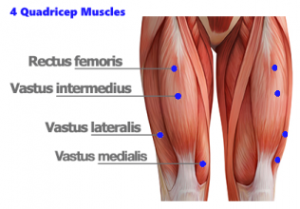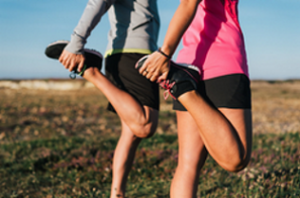Some temporary aches and pains can be ignored, but when your knee is the culprit, you want some relief fast. It is not easy when the knee joint flares up because you need it to do even the simplest action.
In fact, the pain seems wretched, since it stops you from living life to the fullest.
The knee is used to facilitate walking, running, turning, bending, support in lifting, and pretty well all movement your body makes.
As the pain worsens, it can be incredibly difficult to perform normal tasks like walking up the stairs, getting out of your vehicle, or climbing into the bathtub.
All of these everyday functions require the knee to support and steady the body. The rest of the body gets its momentum from the thrust of the knee.
If the knee is not working properly, creating discomfort, whether minor or severe, you definitely want to learn about stretching to relieve knee pain.
Minimize Pain and Improve Fitness
Aside from the obvious benefit of stretching to relieve knee pain, your overall fitness levels will increase when you follow a proper series of stretches to reduce knee pain.
 Although certain exercises target specific areas of the body, that part of the body does not receive all the benefits. For example, by strengthening the knees, you may also be helping the hips.
Although certain exercises target specific areas of the body, that part of the body does not receive all the benefits. For example, by strengthening the knees, you may also be helping the hips.
In cases where you have injuries that cannot be repaired such as a severely torn meniscus, where surgery is not a viable option, working on the surrounding area can help to restore some strength in the knee.
If you have ever suffered with some sort of meniscus-related injury, you know that often, the knee gives out without warning. It doesn’t have the support to do what you ask of it.
At this point, it is important to think about stretching for relief of the knee. If you can’t do anything about the meniscus itself, therapy to compensate for the condition is recommended.
Further, for a long time, it was thought that chronic pain required rest and inactivity to heal. Studies prove, however, that stretches are more conducive to pain relief. That is why when you seek medical attention, physical therapy is often prescribed nowadays.
The truth is, as you lessen the pain with stretching, you also increase the endorphins which make you feel better. Not only does your knee feel good, but so does your psyche. The exercises help the whole body in many ways, including fitness so that you can do the activities you love and enjoy.
How Does Stretching To Relieve Knee Pain Work?
Because the knee is a joint, you actually do the stretches to loosen and strengthen the muscles and tendons found around the knee.
Targeting these five areas will provide the most benefit for your knee’s health and to help you with your discomfort.
#1 Hamstrings:
Hamstrings are three muscles located in the back area of the thigh.
Oddly enough, if they are too tight, they can actually be the cause of the pain in the knee.
By performing a few hamstring stretches each day to lengthen the muscles, you should be able to improve the flexibility in your knee, and also, reduce the pain at the same time.
Probably, the easiest hamstring stretch to increase your range of mobility is one you can do lying on the floor or on the bed.
Pull one knee up, holding the back of the thigh with both hands. Bend the leg at the knee and point the leg to the ceiling. Only hold this pose for one second, then continue doing several repetitions.
#2 Hips:
If you don’t move around enough, both your hips and knees seize up to the point that they just don’t provide any flexibility at all.
This is true for individuals that sit for long periods of time whether at work, school or in front of the TV.
The situation can leave you in agony because the body doesn’t work that well without the use of the knee and hip joints.
To loosen up the hips, lie on your side, then lift the top leg so that you make a sideways V with your legs. Try to do this ten times each, and if you are able, complete these repetitions three times a day. Remember that the movement is slow and easy, not fast and jerky.
#3 Calves:
Without being able to see inside our bodies, it is difficult to understand how everything works together in unison to keep us walking and moving about.
For example, the muscles in the calves are connected to the hamstrings by tissue called fascia. The hamstrings, then support the back of the knee.
By targeting calf stretching to relieve knee pain, you also strength the muscles, so that there is less strain on the knee itself. The calf muscles absorb some of the shock, so that the knee is not injured.
A simple heel or calf raise can help with strengthening, loosening, and restoring full range of movement. Stand with your feet touching each other. Move up your heels until your feel the stretch in the back of your legs. Return your heels to the floor. For individuals that have difficulty standing on tippy toes, wear your running shoes for added stability.
#4 Quadriceps:
The quadriceps muscle is found in the upper leg between the knee and the hip. Although all muscles of the body are important, this one is particularly crucial to the proper movement of the knee and the hip.
As the hip joint bends, this muscle straightens the knee. It also provides stability to the knee when the body is moving. Any damage to this muscle or a quadriceps that is not working properly will cause extreme pain in the knees or hips or even both.
Stretching to relieve knee pain is essential to increase strength and flexibility. By keeping the
quadriceps muscle fit, you automatically enhance the knee’s performance.
One of the best quadriceps stretches for this is raising your leg straight in the air. Lie on the floor on your back. Lift one leg about a foot off the floor, keeping your knee straight. Hold briefly, then lower your leg. Do this stretch to both legs for about ten to fifteen repetitions.
#5 Iliotibial Band:
More commonly called the IT band, the iliotibial band is tissue that connects the hip, knee, and shinbone. It is located on the outer side of the leg, and assists the rotation of the hip, and the stability in the knee.
When damaged, it is often called IT Band Syndrome. Injury is common to this fascia, since it involves continuous repetitive motions. It is often abused and overused. Once it is irritated, or too tight to work properly, it causes friction from rubbing on the knee bone, resulting in shooting pain.
Usually a daily routine of strengthening stretching to relieve knee pain will be ordered. These exercises will lengthen and loosen the tissue, removing the discomfort in the knee and hip regions.
An exercise that can be done anywhere is stretching to the side. While standing straight, cross one leg over the other at the knee. Both feet remain on the floor. With the opposite arm to the knee, stretch your arm over your head. You will feel the stretch in both the knee and hip.
Knee Strengthening Exercises
As you can more readily understand now, although the end goal is to perform consistent regular stretching to relieve knee pain, often the pain is caused by another part of the body.
The muscles, tendons, and connective tissues need strengthening, as well as lengthening, in order for the pain in the knee to go away.
Since all of the elements work together like a well-tuned piano, it is necessary to target several areas all the way down from the hips to the toes.
Knee Friendly Cardio
Many individuals want the added benefit of cardiovascular activity when doing their stretches. This is a great combination for keeping the body fit and the heart healthy.
The problem is with many cardio exercises, because you are trying to increase the heart rate, they are a little more vigorous than stretching alone. In fact, many require excessive use of the knee which is what you are trying to avoid when you experience discomfort.
If stretching for relief of knee pain, you need some knee friendly cardio.
- Choose walking instead of running or jogging.
- Consider enrolling in an aqua aerobics class or swimming at the local pool.
- Avoid the treadmill. Instead, use an elliptical machine if you have access to the equipment.
- Good old fashioned bike riding can also increase cardio, while safe to the knee.
Finally, you can add more difficult poses to your stretching exercises in order to get that heart pumping.
Final Thoughts on Stretching to Relieve Knee Pain
Regardless of the reason for your pain in the knee, there are plenty of exercises available for all levels of ability to employ in order to diminish the agony.
Medical studies and science now demonstrate that stretching to relieve knee pain is a completely sound form of treatment whether you have knee osteoarthritis, bursitis, muscle or tissue injury, or simply sore legs due to tight and overused muscles, tendons, and fascias.

